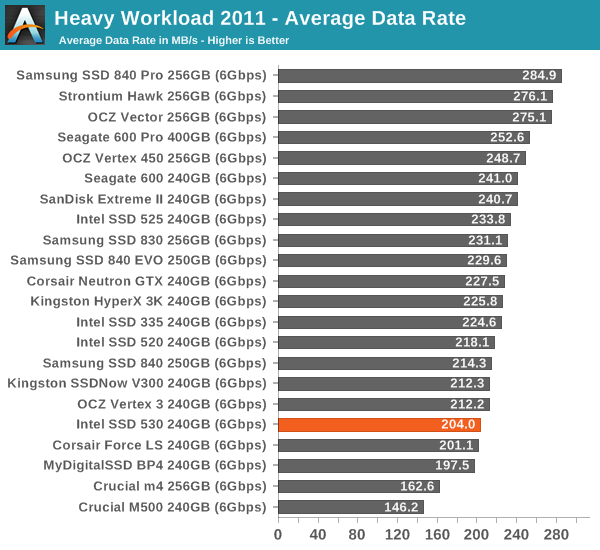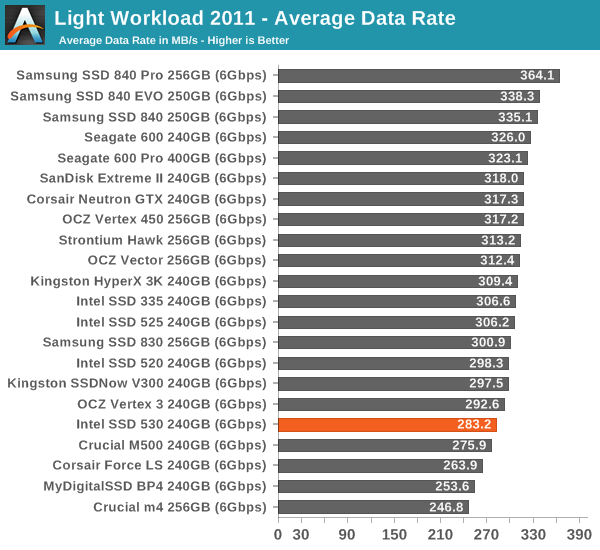Intel SSD 530 (240GB) Review
by Kristian Vättö on November 15, 2013 1:45 PM EST- Posted in
- Storage
- SSDs
- Intel
- Intel SSD 530
AnandTech Storage Bench 2011
Two years ago we introduced our AnandTech Storage Bench, a suite of benchmarks that took traces of real OS/application usage and played them back in a repeatable manner. Anand assembled the traces out of frustration with the majority of what we have today in terms of SSD benchmarks.
Although the AnandTech Storage Bench tests did a good job of characterizing SSD performance, they weren't stressful enough. All of the tests performed less than 10GB of reads/writes and typically involved only 4GB of writes specifically. That's not even enough exceed the spare area on most SSDs. Most canned SSD benchmarks don't even come close to writing a single gigabyte of data, but that doesn't mean that simply writing 4GB is acceptable.
Originally I kept the benchmarks short enough that they wouldn't be a burden to run (~30 minutes) but long enough that they were representative of what a power user might do with their system.
Not too long ago I tweeted that I had created what I referred to as the Mother of All SSD Benchmarks (MOASB). Rather than only writing 4GB of data to the drive, this benchmark writes 106.32GB. It's the load you'd put on a drive after nearly two weeks of constant usage. And it takes a *long* time to run.
1) The MOASB, officially called AnandTech Storage Bench 2011 - Heavy Workload, mainly focuses on the times when your I/O activity is the highest. There is a lot of downloading and application installing that happens during the course of this test. My thinking was that it's during application installs, file copies, downloading and multitasking with all of this that you can really notice performance differences between drives.
2) I tried to cover as many bases as possible with the software I incorporated into this test. There's a lot of photo editing in Photoshop, HTML editing in Dreamweaver, web browsing, game playing/level loading (Starcraft II & WoW are both a part of the test) as well as general use stuff (application installing, virus scanning). I included a large amount of email downloading, document creation and editing as well. To top it all off I even use Visual Studio 2008 to build Chromium during the test.
The test has 2,168,893 read operations and 1,783,447 write operations. The IO breakdown is as follows:
| AnandTech Storage Bench 2011 - Heavy Workload IO Breakdown | ||||
| IO Size | % of Total | |||
| 4KB | 28% | |||
| 16KB | 10% | |||
| 32KB | 10% | |||
| 64KB | 4% | |||
Only 42% of all operations are sequential, the rest range from pseudo to fully random (with most falling in the pseudo-random category). Average queue depth is 4.625 IOs, with 59% of operations taking place in an IO queue of 1.
Many of you have asked for a better way to really characterize performance. Simply looking at IOPS doesn't really say much. As a result I'm going to be presenting Storage Bench 2011 data in a slightly different way. We'll have performance represented as Average MB/s, with higher numbers being better. At the same time I'll be reporting how long the SSD was busy while running this test. These disk busy graphs will show you exactly how much time was shaved off by using a faster drive vs. a slower one during the course of this test. Finally, I will also break out performance into reads, writes and combined. The reason I do this is to help balance out the fact that this test is unusually write intensive, which can often hide the benefits of a drive with good read performance.
There's also a new light workload for 2011. This is a far more reasonable, typical every day use case benchmark. Lots of web browsing, photo editing (but with a greater focus on photo consumption), video playback as well as some application installs and gaming. This test isn't nearly as write intensive as the MOASB but it's still multiple times more write intensive than what we were running in 2010.
As always I don't believe that these two benchmarks alone are enough to characterize the performance of a drive, but hopefully along with the rest of our tests they will help provide a better idea.
The testbed for Storage Bench 2011 has changed as well. We're now using a Sandy Bridge platform with full 6Gbps support for these tests.
AnandTech Storage Bench 2011 - Heavy Workload
We'll start out by looking at average data rate throughout our new heavy workload test:

Performance in our 2011 Storage Bench is a bit below the average of SF-2281, although the difference isn't anything to worry about. I decided to include only the most important graphs but you can find the complete dataset in our Bench.
AnandTech Storage Bench 2011 - Light Workload
Our light workload actually has more write operations than read operations. The split is as follows: 372,630 reads and 459,709 writes. The relatively close read/write ratio does better mimic a typical light workload (although even lighter workloads would be far more read centric).
The I/O breakdown is similar to the heavy workload at small IOs, however you'll notice that there are far fewer large IO transfers:
| AnandTech Storage Bench 2011 - Light Workload IO Breakdown | ||||
| IO Size | % of Total | |||
| 4KB | 27% | |||
| 16KB | 8% | |||
| 32KB | 6% | |||
| 64KB | 5% | |||











60 Comments
View All Comments
Magichands8 - Friday, November 15, 2013 - link
"It will be interesting to see what Intel's approach will be with SATA Express..."Apparently Intel's approach is to ignore it as SATA Express won't be a part of Intel's 9-series chipset to be released next year. So God knows when we'll have any reasonable access to it. It seems that the only place left for SSD makers to go in order to differentiate their products is to reduce price/increase capacity. And when SSDs finally start hitting 2+ TB per device at reasonable prices our only option will be to resort to RAID 0 to get around the SATA albatross hanging around our necks.
Hrel - Friday, November 15, 2013 - link
The Seagate 600 and Crucial M500 outperform the Intel drive and are a whopping $50 less. I see no value gained for paying more than $150 for a 256GB SSD. Am I missing something or is every 256GB drive over $150 as bad a deal as I think?Laststop311 - Sunday, November 17, 2013 - link
Samsung 840 pro is worth every penny. Not only does it consistently fall in the top 3 for sequential reads and random reads it also falls in the top 3 for lowest power used. It is the only ssd on the market to perform that high while using that low of wattage. It's something special and has reigned supreme the entire 14ish months it's been out.You really need to look for deals on it though. Like newegg is selling the 512GB for 480 but I went on ebay and found a brand new sealed in box for 389.00 free shipping and no tax. 480 is a lot of omney for a 512GB but for 389 at that deal how can you buy any other 500GB capacity drive. Also these samsung drives perform noticeably at their very best if you leave 20% of it untouched so out of the 512GB you really should leave 102GB free and just use 410GB. Thats why you should buy 1 capacity size over what you need so you can properly over provision and have maximum iops at all times.
I transfered a 200GB file from a 750GB samsung evo ssd to the 512GB 840 pro in a few seconds under 7 minutes. Thats pretty insane speed 200GB in less then 7 mins. Thats basically sata III being saturated. And it's saturates it while using the lowest power of ssd's in similiar situations.
So yes 240 dollars is a lot for 256GB but I have seen them go on sale for 190 and you can search ebay too. Don't settle for a cheap ssd with poor power efficiency and slower speeds.
purerice - Sunday, November 17, 2013 - link
I'm in the same boat you are. Seagate seemed to be near the top in most categories and used less power (perhaps over more time?) than Samsung 840 Pro and Intel... yet for a lot less money.For me especially, I'm still running on a 7200rpm drive for 90% of my work. The other 10% is 5400rpm. Even the slowest of these drives so so insanely faster than what I have that the marginal difference of anything above the Seagate gets lost in the wash.
MikeMurphy - Friday, January 10, 2014 - link
This isn't a top drive, but it offers good performance, all-important low idle power consumption, access to the extremely helpful Intel SSD Toolbox, Intel reliability and a 5-year warranty.I'm happy to spend a couple extra bucks for this feature set.
supax - Friday, November 15, 2013 - link
I actually just picked up a Seagate 600 240GB for $130 after $20 MIR. Seemed like a better deal to me anyway.jwcalla - Friday, November 15, 2013 - link
So is it confirmed that SF-22xx series drives work on Haswell chipsets? Is it only the SF-12xx series that doesn't work or is it still a mixed bag of guesswork?iwod - Friday, November 15, 2013 - link
I was just discussing this earlier. Since Intel decided to ditch the SATA Express, may be we are moving straight to PCI-E Native instead? The thing is we already have PCI-E Native SSD from Apple in many of its consumer Mac already already using it. And the trend will likely continue in next year. Since we are not going to get SATA Express until late next year with the original Intel 9 series chipset. Intel thought it may have been too late anyway and ditch it instead?Kristian Vättö - Sunday, November 17, 2013 - link
SATA Express is PCIe. SATA Express is simply the name of the connector which combines SATA and PCIe into one (i.e. the same connector works with SATA and PCIe devices).http://www.anandtech.com/show/6294/breaking-the-sa...
Morawka - Saturday, November 16, 2013 - link
The biggest fail of the year is when Asus put the M.2 Connector on a PCI 1.0 Bus. GG ASUS are you retarded?